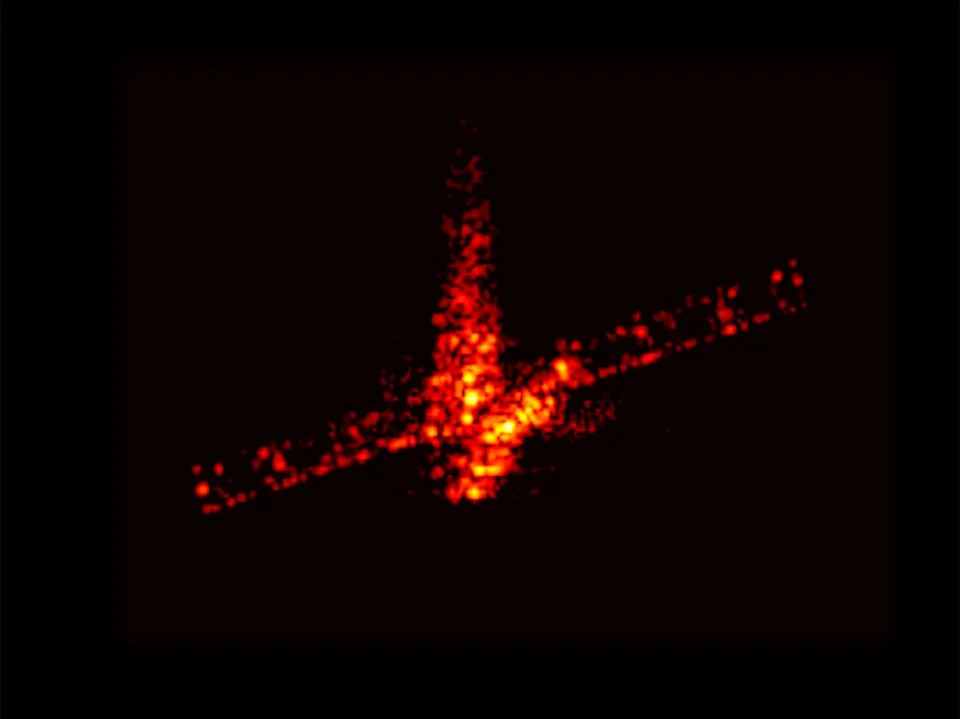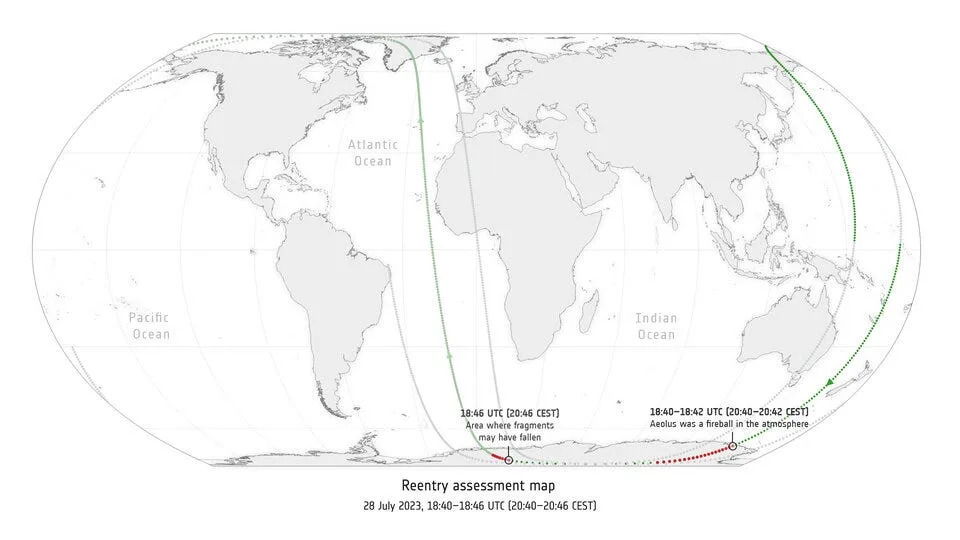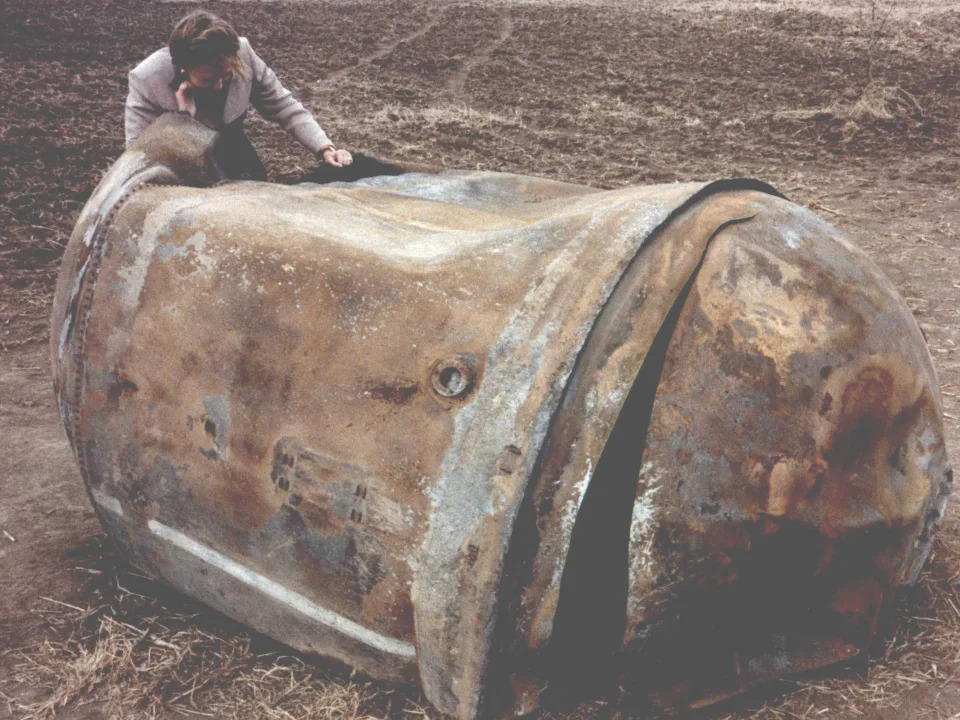Grace Eliza Goodwin,Maiya Focht
Fri, September 8, 2023

Aeolus was the first satellite to study winds on Earth at a global scale.European Space Agency
Photos show a European satellite tumbling to its doom before burning up in Earth's atmosphere.
The European Space Agency performed a first-of-a-kind maneuver on the satellite as it deorbited.
ESA said the maneuver reduced the risk of dangerous space debris impact and space junk collision.
The European Space Agency released photos showing its Aeolus satellite tumbling to a fiery death as it re-entered Earth's atmosphere at a blazing 16,700 mph.
The Aeolus satellite was launched to space in 2018. It was the first satellite with powerful laser technology capable of observing wind on a global scale.
Over its 5-year mission, Aeolus improved weather forecasts and climate models, according to ESA. But Aeolus retired in July, at which point it went from a cutting-edge satellite to mere space junk.

The Aeolus satellite burning up as it falls over Antarctica.
Fraunhofer FHR/European Space Agency
When nearby satellites are no longer useful, they usually fall out of orbit, back to Earth, and burn up in our planet's atmosphere, according to NASA.
That is, indeed, what happened with Aeolus but in a more controlled way than is typical.
ESA took Aeolus's end as an opportunity to try a first-of-a-kind reentry maneuver called an "assisted reentry," ESA said in a statement Tuesday.
How assisted reentries could make satellite decommissioning safer
The assisted reentry maneuver involved a series of deorbits, where the satellite inched closer and closer to Earth, but remained in orbit.
This let ESA accurately map where the satellite would ultimately reenter Earth's atmosphere, helping to reduce the risk of any debris that didn't completely burn up from landing near any populated area.
Ultimately, ESA calculated the satellite would renter and burn up over Antarctica, far from any populated areas. About 80% of the satellite burned up and 20% survived reentry, per Space.com.

Map showing Aeolus satellite's location as it inched closer to Earth where it ultimately burned up over Antarctica.
When nearby satellites are no longer useful, they usually fall out of orbit, back to Earth, and burn up in our planet's atmosphere, according to NASA.
That is, indeed, what happened with Aeolus but in a more controlled way than is typical.
ESA took Aeolus's end as an opportunity to try a first-of-a-kind reentry maneuver called an "assisted reentry," ESA said in a statement Tuesday.
How assisted reentries could make satellite decommissioning safer
The assisted reentry maneuver involved a series of deorbits, where the satellite inched closer and closer to Earth, but remained in orbit.
This let ESA accurately map where the satellite would ultimately reenter Earth's atmosphere, helping to reduce the risk of any debris that didn't completely burn up from landing near any populated area.
Ultimately, ESA calculated the satellite would renter and burn up over Antarctica, far from any populated areas. About 80% of the satellite burned up and 20% survived reentry, per Space.com.

Map showing Aeolus satellite's location as it inched closer to Earth where it ultimately burned up over Antarctica.
European Space Agency
"By turning Aeolus's natural, uncontrolled reentry into an assisted one, and choosing the best reentry orbit, the already very small risk from any surviving fragments landing near populated areas was made a further 150 times less risky," ESA said.
Moreover, the assisted reentry approach meant "the time during which Aeolus was left uncontrolled in orbit was shortened by a few weeks, limiting the risk of collision with other satellites in this vital space highway," ESA said in the statement.
More space junk, more risk, more action needed
There were over 6,000 active, working satellites in orbit as of 2022, compared to just under 1,000 in 2010. This means there's more risk of satellites crashing into one another, and that space debris flying to inhabited places on Earth.
Though no one has ever been severely harmed by space debris, the risk is real and growing greater as more satellites enter Earth's orbit, ESA said.
"By turning Aeolus's natural, uncontrolled reentry into an assisted one, and choosing the best reentry orbit, the already very small risk from any surviving fragments landing near populated areas was made a further 150 times less risky," ESA said.
Moreover, the assisted reentry approach meant "the time during which Aeolus was left uncontrolled in orbit was shortened by a few weeks, limiting the risk of collision with other satellites in this vital space highway," ESA said in the statement.
More space junk, more risk, more action needed
There were over 6,000 active, working satellites in orbit as of 2022, compared to just under 1,000 in 2010. This means there's more risk of satellites crashing into one another, and that space debris flying to inhabited places on Earth.
Though no one has ever been severely harmed by space debris, the risk is real and growing greater as more satellites enter Earth's orbit, ESA said.

Space debris that landed in Texas.NASA
The more traffic there is up there, the more likely it is that debris may rain down, ESA said. Especially as satellites that have become defunct continue to operate above without directions from Earth.
With these factors in mind, ESA is promising to be more careful when it comes to their space junk. "Making space missions safer is a particularly important matter of concern for the agency," ESA said.
Aeolus's assisted reentry was part of that mission to make satellite reentry safer.
"With Aeolus, in a remarkable example of sustainable spaceflight and responsible operations, we stayed with the mission for as long as we could, guiding its return as much as it was possible to do," Aeolus Mission Manager Tommaso Parrinello said in the statement.
No comments:
Post a Comment